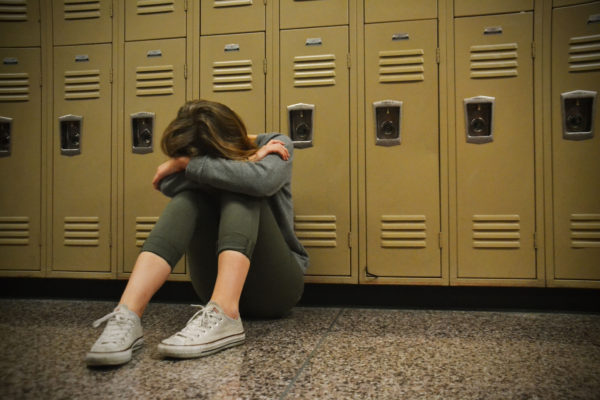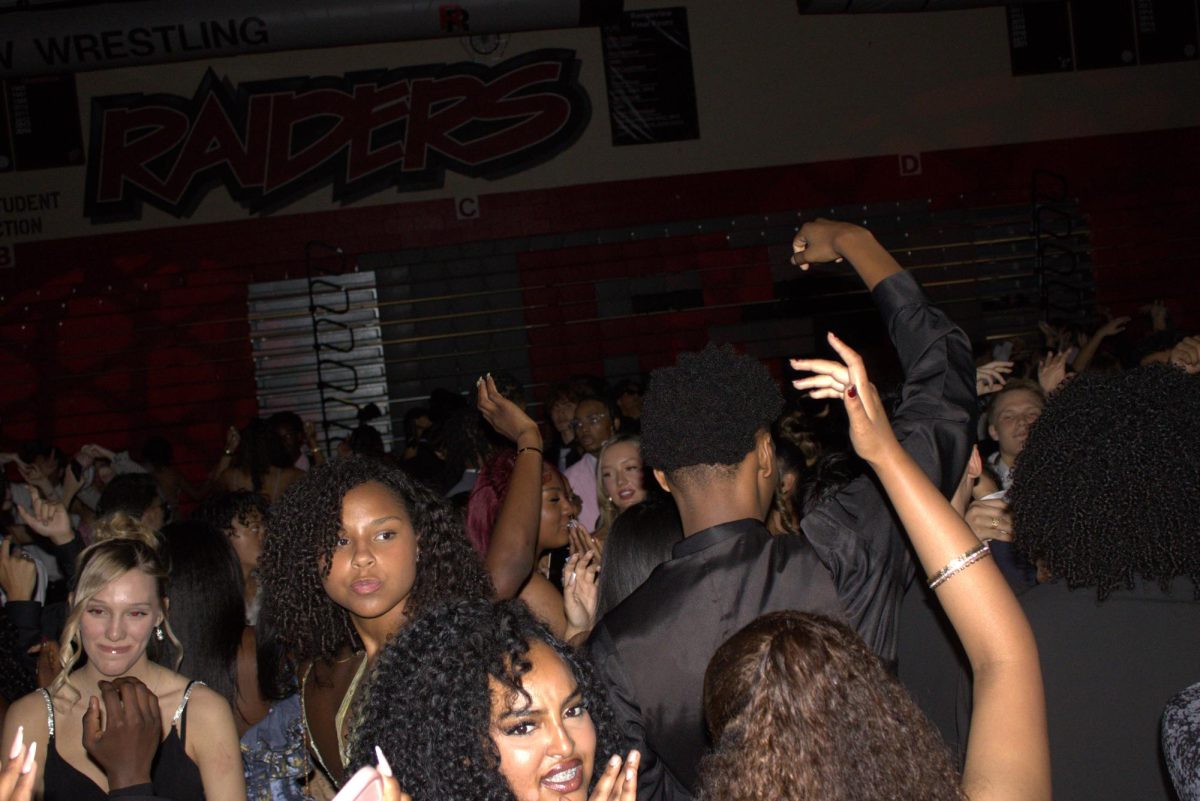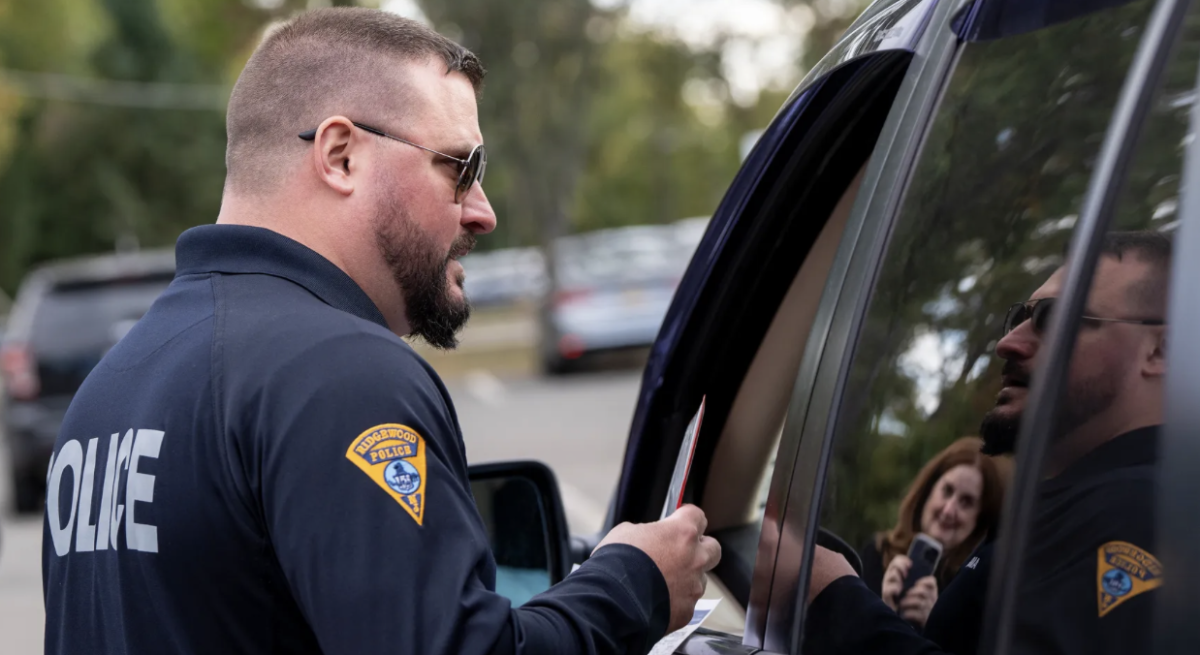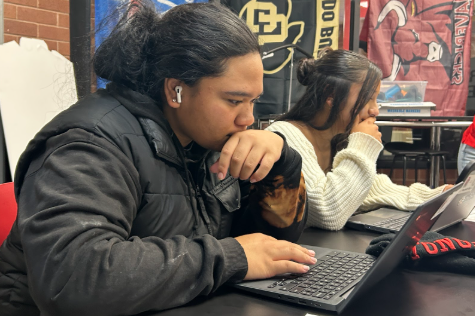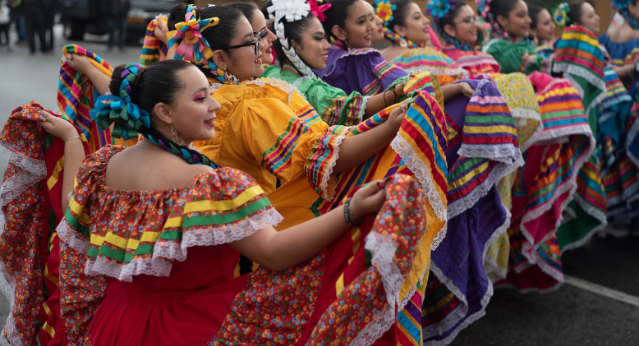Feature Photo By: Izzy Honey – A student sits in a pose that is not uncommon for someone in an abusive relationship. This is a staged photo to show how abuse can impact emotional well-being.
From glorified toxic relationships like The Joker and Harley Quinn, to mainstream songs like Robin Thicke’s “Blurred Lines,” abuse in partnerships is brushed off or praised more than ever within today’s society — especially among teens, experts say.
According to loveisrespect.org, violent relationships statistics are too high, especially in teenagers. The website states that, “nearly 1.5 million high school students nationwide experience physical abuse from a dating partner in a single year.”
Emotional, sexual, and physical abuse are all common in a dangerous teenage relationship; however, many people are oblivious to the violence. In fact, more than 50% of parents cannot correctly identify the signs if their child is in an abusive relationship, according to experts.
It can be very hard for teenagers to come forward with experiences of unhealthy relationships “because it might be embarrassing,” says junior Imanni Faulkner.
Nonetheless, the statistics prove that these issues on toxic relationships need to be addressed. It is important that students, as well as parents, are able to identify the signs of a relationship that is not healthy, as well as how to get help for a friend or for themselves.
The Statistics:
According to loveisrespect.com’s statistics page:
- One in three teens have experienced some form of abuse from a partner.

The Karpman Drama Triangle demonstrates the three people involved in an abusive relationship. The victim and the persecutor are the couple, and the rescuer comes in to help. None of the roles are healthy. (Mya Johnson)
- One in 10 high school students has been purposefully struck by a partner.
- 94% of abused women between 16 and 19 years old are abused by a partner.
- Only a third of teens who experience partner abuse ever tell anyone.
- 58% of parents cannot correctly identify an abusive relationship.
Many people do not have a full idea of what these types of abuse entail, which in turn prevents them from being able to help someone in need.
Junior Dale Robertson-George defines emotional abuse as “threats and insults.”
While he has a good idea of what emotional abuse looks like, his definition does not encompass it entirely.
Laurel Story, a licensed social worker and therapist, stated that emotional abuse is “belittling, demeaning, or degrading your partner to make them feel worthless, hopeless, or insignificant in an effort to control them.”
She says that abuse in teenage relationships is very common and even if it does not classify as abusive, a lot of relationships are extremely unhealthy.
She went on to give the following definition of sexual and physical abuse: “Any type of sexual interaction that is not 100% consensual [is sexual abuse].”
This includes, touching, kissing, harassment, assault, and rape. Physical abuse is sometimes more noticeable because it leaves marks, Story said. This kind of abuse includes “hitting, punching, or slapping your partner or lashing out in a physical way that creates physical injury.”
Even though physical abuse is the easiest to identify because of its physical presence, it is not always the most harmful, according to Story.
Beth Parks, a child and family therapist, says emotional abuse is “more detrimental than the other [types of abuse],” because it cannot be seen and it is extremely easy for the abuser to hide. It also makes the victim feel crazy or that they are blowing things out of proportion because, often times, the abuser will be a good person in others’ eyes (Parks).
Because abusive relationships are so damaging and “can have a lasting impact on how people view romantic relationships in the future” (Story), it is so important to recognize if you or someone you care about is in a harmful relationship. Story and Parks offer some of these signs.
Signs a friend is experiencing abuse:
Controlling Behavior: The abuser will want to know where their partner is at all times and may demand access to their phone. “If both people in the relationship don’t have the freedom to make their own choices, be their own people, and maintain separate identities outside of the relationship, it’s not healthy.”
Isolation: The abuser makes their partner cut off friendships and prevent them from spending time with people they care about. Often, they will force their partner to cut out people that the victim has been close with for a very long time.
Intimidation: “Forcing a partner to do something they don’t want to do and don’t feel comfortable with.”
NSSU: This stands for non-suicidal self injury. This includes cutting and may involve “a lot of poor self esteem.”
According to Parks and Story, there is a lot that you are able to do for a friend in a toxic relationship. If you see a dangerous relationship, the best thing is to reach out and get help.
Parks says, “Just listening and not being critical or judgmental” is the best thing a friend can do. It is never good to shame or put down a victim of relationship abuse.
If it seems like you should take action, there is a lot that you can do as a friend of someone getting out of an abusive relationship. The counseling office is always ready to talk to students if they need relationship help, with a walk-in counselor daily. You can go with your friend and support them while they get help. If your friend needs other support, you can always join them in talking to an adult at the school.
There are also ways that the person that is being abused can recognize signs and get out of the toxic relationship. Though this is hard, it is possible. Helpguide.org lists some signs of abuse from within the relationship.
Signs you’re in an abusive relationship:
Feeling Unsafe: You feel that you are in danger around your partner; you are afraid to bring certain things up and do certain things because it might set your partner off; you often cower at your partner, or are afraid of their touch. (Helpguide.org)
Partner’s Behavior: He or she may say things that put you down or make you feel worthless, sometimes to the point that you believe your partner. He or she pushes you around and often embarrasses you, blaming you for the abuse. Jealousy is a big problem in the relationship, and you have been accused of cheating several times. You also do not have any privacy because your partner demands access to your phone and other personal belongings. (Helpguide.org)
If any of these things bring a couple to mind, or even you and your own partner, there are many ways to get help. You are never alone and there are people that you can reach out to.

Faulkner says that it’s hard to get out of an abusive relationship “because it can be embarrassing,” but there are resources out there to help with victims of relational abuse.
Ideally, when people are getting out of an unhealthy relationship, they will be able to get help from a parent; Parks explains that unfortunately, students often get into bad relationships because they have poor home lives and absent parents.
Robertson-George says, “It’s not always easy [to get help], especially if they’re threatening you.”
Nonetheless, there are so many resources that someone getting out of a damaging relationship has access to:
- If you are too afraid to talk to someone you know, there are a couple different resources that allow anonymity. These include The National Domestic Violence Hotline and the National Sexual Assault Telephone Hotline which both have a phone number you can call or live chat an online representative.
- As a student, and in the twenty-first century, there are many other resources readily available. Love Is Respect has a page dedicated to how to get help and who to talk to when in need. Many other websites are out there as well, all with a lot of help.
- If you are able to, talk to friends, family, or adults you trust at school. Many teachers are willing to help students in the case of abuse.
In fact, an anonymous Rangeview student said that, while she was in a dangerous relationship, her family was the most helpful. Also, when she was able to get out of the relationship, the best thing she had was the friends she was able to reconnect with.
She felt scared, depressed, and had no self worth after spending so much time with her harmful partner. But there is always hope. “After [the relationship] I felt like that was all I ever knew so that’s all I was going to get. But later, I realized that I was going to get better, and the relationship was not normal.” She added that it is important to know what resources you have and to realize that help is out there.
The statistics show you are not alone. As the anonymous student said, “Don’t feel trapped because there’s always a way out and people that will listen.”
